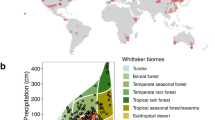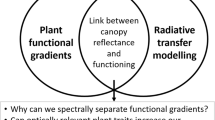Abstract
The study of leaf functional trait relationships, the so-called leaf economics spectrum1,2, is based on the assumption of high-light conditions (as experienced by sunlit leaves). Owing to the exponential decrease of light availability through canopies, however, the vast majority of the world's vegetation exists in at least partial shade. Plant functional traits vary in direct dependence of light availability3, with different traits varying to different degrees, sometimes in conflict with expectations from the economic spectrum3. This means that the derived trait relationships of the global leaf economic spectrum are probably dependent on the extent to which observed data in existing large-scale plant databases represent high-light conditions. Here, using an extensive worldwide database of within-canopy gradients of key physiological, structural and chemical traits3, along with three different global trait databases4,5, we show that: (1) accounting for light-driven trait plasticity can reveal novel trait relationships, particularly for highly plastic traits (for example, the relationship between net assimilation rate per area (Aa) and leaf mass per area (LMA)); and (2) a large proportion of leaf traits in current global plant databases reported as measured in full sun were probably measured in the shade. The results show that even though the majority of leaves exist in the shade, along with a large proportion of observations, our current understanding is too focused on conditions in the sun.
This is a preview of subscription content, access via your institution
Access options
Subscribe to this journal
Receive 12 digital issues and online access to articles
$119.00 per year
only $9.92 per issue
Buy this article
- Purchase on Springer Link
- Instant access to full article PDF
Prices may be subject to local taxes which are calculated during checkout



Similar content being viewed by others
References
Reich, P. B. The world-wide ‘fast-slow’ plant economics spectrum: a traits manifesto. J. Ecol. 102, 275–301 (2014).
Wright, I. J. et al. The worldwide leaf economics spectrum. Nature 428, 821–827 (2004).
Niinemets, Ü., Keenan, T. F. & Hallik, L. A worldwide analysis of within-canopy variations in leaf structural, chemical and physiological traits across plant functional types. New Phytol. 205, 973–993 (2015).
Poorter, H., Niinemets, U., Poorter, L., Wright, I. J. & Villar, R. Causes and consequences of variation in leaf mass per area (LMA): a meta-analysis. New Phytol. 182, 565–588 (2009).
Niinemets, Ü. Components of leaf dry mass per area thickness and density alter leaf photosynthetic capacity in reverse directions in woody plants. New Phytol. 144, 35–47 (1999).
Westoby, M. A leaf-height-seed (LHS) plant ecology strategy scheme. Plant Soil 199, 213–227 (1998).
Craine, J. M. Resource strategies of wild plants (Princeton Univ. Press, 2009).
Bonan, G. B., Oleson, K. W., Fisher, R. A., Lasslop, G. & Reichstein, M. Reconciling leaf physiological traits and canopy flux data: use of the TRY and FLUXNET databases in the Community Land Model version 4. J. Geophys. Res. Biogeosci. 117, 1–19 (2012).
van Bodegom, P. M., Douma, J. C. & Verheijen, L. M. A fully traits-based approach to modeling global vegetation distribution. Proc. Natl Acad. Sci. USA 111, 13733–8 (2014).
Hirose, T., Werger, M. J. A., Pons, T. L. & Vanrheenen, J. W. A. Canopy structure and leaf nitrogen distribution in a stand of lysimachia-vulgaris L as influenced by stand density. Oecologia 77, 145–150 (1988).
Joffre, R., Rambal, S. & Damesin, C. in Handbook of Functional Plant Ecology (eds Pugnaire, F. I. & Valladares, F. ) 285–312 (CRC, 2007).
Niinemets, Ü. in Canopy Photosynthesis: From Basics to Applications (eds Hikosaka, K., Niinemets, Ü. & Anter, N. P. R. ) 101–141 (Springer, 2016).
Hirose, T . & Werger, M. J. A. Maximizing dialy canopy phoytosynthesis with respect to the leaf nitrogen allocation pattern in the canopy. Oecologia 72, 520–526 (1987).
Ellsworth, D. S. & Reich, P. B. Canopy structure and vertical patterns of photosynthesis and related leaf traits in a deciduous forest. Oecologia 96, 169–178 (1993).
Anten, N. P. R. Modelling canopy photosynthesis using parameters determined from simple non-destructive measurements. Ecol. Res. 12, 77–88 (1997).
Pons, T. L. & Anten, N. P. R. Is plasticity in partitioning of photosynthetic resources between and within leaves important for whole-plant carbon gain in canopies? Funct. Ecol. 18, 802–811 (2004).
Niinemets, Ü. & Anten, N. P. R. in Photosynthesis In Silico: Understanding Complexity from Molecules to Ecosystems (eds Laisk, A., Nedbal, L. & Govindjee, J. ) 363–399 (Springer, 2009).
Jetz, W. et al. Monitoring plant functional diversity from space. Nat. Plants 2, 16024 (2016).
Ollinger, S. V. Sources of variability in canopy reflectance and the convergent properties of plants. New Phytol. 189, 375–94 (2011).
Keenan, T. F. & Niinemets, Ü . The canopy trait plasticity (CANTRIP) database V1.0.0. (Zenodo, 2016).
Niinemets, Ü., Kull, O. & Tenhunen, J. D. Within-canopy variation in the rate of development of photosynthetic capacity is proportional to integrated quantum flux density in temperate deciduous trees. Plant Cell Environ. 27, 293–313 (2004).
Niinemets, Ü. & Keenan, T. F. Measures of light in studies on light-driven plant plasticity in artificial environments. Front. Plant Sci. 3, 156 (2012).
Niinemets, Ü. Leaf age dependent changes in within-canopy variation in leaf functional traits: a meta-analysis. J. Plant Res. 129, 313–338 (2016).
Niinemets, Ü. Is there a species spectrum within the world-wide leaf economics spectrum? major variations in leaf functional traits in the Mediterranean sclerophyll Quercus ilex. New Phytol. 205, 79–96 (2015).
Hoover, C. M . Field Measurements for Forest Carbon Monitoring (Springer, 2008).
Ollinger, S. V. et al. Canopy nitrogen, carbon assimilation, and albedo in temperate and boreal forests: functional relations and potential climate feedbacks. Proc. Natl Acad. Sci. USA 105, 19336–19341 (2008).
Lloyd, J., Bloomfield, K., Domingues, T. F. & Farquhar, G. D. Photosynthetically relevant foliar traits correlating better on a mass vs an area basis: of ecophysiological relevance or just a case of mathematical imperatives and statistical quicksand? New Phytol. 199, 311–321 (2013).
Osnas, J. L. D., Lichstein, J. W., Reich, P. B. & Pacala, S. W. Global leaf trait relationships: mass, area, and the leaf economics spectrum. Science 340, 741–744 (2013).
Poorter, H., Lambers, H. & Evans, J. R. Trait correlation networks—a whole-plant perspective on the recently criticized leaf economic spectrum. New Phytol. 201, 378–382 (2013).
Westoby, M., Reich, P. B. & Wright, I. J. Understanding ecological variation across species: area-based vs mass-based expression of leaf traits. New Phytol. 199, 322–323 (2013).
Poorter, H., Niinemets, Ü., Walter, A., Fiorani, F. & Schurr, U. A method to construct dose-response curves for a wide range of environmental factors and plant traits by means of a meta-analysis of phenotypic data. J. Exp. Bot. 61, 2043–2055 (2010).
Moorthy, I. et al. Field characterization of olive (Olea europaea L.) tree crown architecture using terrestrial laser scanning data. Agric. For. Meteorol. 151, 204–214 (2011).
Widlowski, J. L. et al. The fourth radiation transfer model intercomparison (RAMI-IV): proficiency testing of canopy reflectance models with ISO-13528. J. Geophys. Res. Atmos. 118, 6869–6890 (2013).
Cescatti, A. & Niinemets, Ü. in Photosynthetic Adaptation. Chloroplast to Landscape (eds Smith, W. K., Vogelmann, T. C. & Chritchley, C. ) 42–85 (Springer, 2004).
Prévost, M. & Raymond, P. Effect of gap size, aspect and slope on available light and soil temperature after patch-selection cutting in yellow birch–conifer stands, Quebec, Canada. For. Ecol. Manage. 274, 210–221 (2012).
Acknowledgements
T.F.K. acknowledges the financial support from the Laboratory Directed Research and Development (LDRD) fund under the auspices of Department of Energy, Biological and Environmental Research Office of Science at Lawrence Berkeley National Laboratory. Ü.N. acknowledges the European Regional Development Fund (Centre of Excellence EcolChange) and the Estonian Ministry of Science and Education (institutional grant IUT-8-3). The authors acknowledge useful feedback from W. Han on an earlier version of the manuscript.
Author information
Authors and Affiliations
Contributions
T.F.K. and Ü.N. conceived the analysis. T.F.K. performed the analysis and both authors participated in drafting the manuscript.
Corresponding author
Ethics declarations
Competing interests
The authors declare no competing financial interests.
Supplementary information
Supplementary Information
Supplementary Figures 1–6. (PDF 1869 kb)
Rights and permissions
About this article
Cite this article
Keenan, T., Niinemets, Ü. Global leaf trait estimates biased due to plasticity in the shade. Nature Plants 3, 16201 (2017). https://doi.org/10.1038/nplants.2016.201
Received:
Accepted:
Published:
DOI: https://doi.org/10.1038/nplants.2016.201
This article is cited by
-
Foliar chemical composition and respiration rates of sugar maple (Acer saccharum) and American beech (Fagus grandifolia) trees across a gradient of soil acidification
Biogeochemistry (2023)
-
Quantifying functional trait assembly along a temperate successional gradient with consideration of intraspecific variations and functional groups
Plant Ecology (2023)
-
Leaf-level coordination principles propagate to the ecosystem scale
Nature Communications (2023)
-
Leaf water content contributes to global leaf trait relationships
Nature Communications (2022)
-
Metal‐rich soils increase tropical tree stoichiometric distinctiveness
Plant and Soil (2021)



